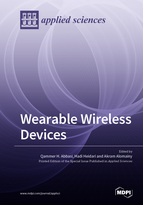Wearable Wireless Devices
A special issue of Applied Sciences (ISSN 2076-3417). This special issue belongs to the section "Electrical, Electronics and Communications Engineering".
Deadline for manuscript submissions: closed (31 January 2019) | Viewed by 52142
Special Issue Editors
Interests: nano communication; biomedical applications of millimeter and terahertz communication; wearable and flexible sensors; compact antenna design; RF design and radio propagation; antenna interaction with human body; implants; body centric wireless communication issues; wireless body sensor networks; non-invasive health care solutions; physical layer security for wearable/implant communication and multiple-input–multiple-output systems
Special Issues, Collections and Topics in MDPI journals
Interests: basics of antennae and electromagnetism, from megastructures and metasurfaces to novel applications in telerobotics, cognitive radio, wearable electronics, nanoscale networks, healthcare, and bioengineering
Special Issues, Collections and Topics in MDPI journals
Interests: flexible wearable and implantable devices; microelectronics design; biomedical circuits and systems
Special Issues, Collections and Topics in MDPI journals
Special Issue Information
Dear Colleagues,
With the growing interest in the use of technology in daily life, the potential of using wearable wireless devices across multiple segments, e.g., healthcare, sports, child monitoring, military, emergency, consumer electronics, etc., is rapidly increasing. It is predicted that there will be multibillion wearable sensors by 2025, with over 30% of them being new types of sensors that are just beginning to emerge. This Special Issue will be focused on wireless wearable and implantable system, flexible textile-based electronics, bio-electromagnetics, antennas and propagation, RF circuits, sensor, security of wearables and implantable system, nano-bio communication and electromagnetic sensing.
Dr. Qammer H. Abbasi
Dr. Akram Alomainy
Dr. Hadi Heidari
Guest Editors
Manuscript Submission Information
Manuscripts should be submitted online at www.mdpi.com by registering and logging in to this website. Once you are registered, click here to go to the submission form. Manuscripts can be submitted until the deadline. All submissions that pass pre-check are peer-reviewed. Accepted papers will be published continuously in the journal (as soon as accepted) and will be listed together on the special issue website. Research articles, review articles as well as short communications are invited. For planned papers, a title and short abstract (about 100 words) can be sent to the Editorial Office for announcement on this website.
Submitted manuscripts should not have been published previously, nor be under consideration for publication elsewhere (except conference proceedings papers). All manuscripts are thoroughly refereed through a single-blind peer-review process. A guide for authors and other relevant information for submission of manuscripts is available on the Instructions for Authors page. Applied Sciences is an international peer-reviewed open access semimonthly journal published by MDPI.
Please visit the Instructions for Authors page before submitting a manuscript. The Article Processing Charge (APC) for publication in this open access journal is 2400 CHF (Swiss Francs). Submitted papers should be well formatted and use good English. Authors may use MDPI's English editing service prior to publication or during author revisions.
Keywords
-
wearables
-
implants
-
sensors
-
antenna’s
-
millimeter wave and terahertz sensing
-
security
-
propagation
-
bio electromagnetic
-
flexible








